

Did you know that one simple change in your website’s internal linking can catapult your website to the top without building a single backlink?
Here’s something surprising: Google has confirmed that internal links help determine the importance of pages on your site. When a page is linked frequently within your website, Google sees it as more valuable, increasing its chances of ranking higher.
A well-structured internal linking strategy can improve rankings without relying on new content or external backlinks, making it a powerful yet often overlooked SEO best practice.
Most websites aren’t doing this right. If you’re not paying attention to your internal links, you’re leaving rankings (and traffic) on the table. Let’s fix that.
|
This guide will cover:
|
Internal linking refers to hyperlinks that connect different pages within the same website. Unlike external links that point to other domains, internal links help create a structured path within your own site.
For example, if you have a blog post about "SEO Best Practices" and another about "Keyword Research," linking these two pages helps users and search engines navigate between related content.
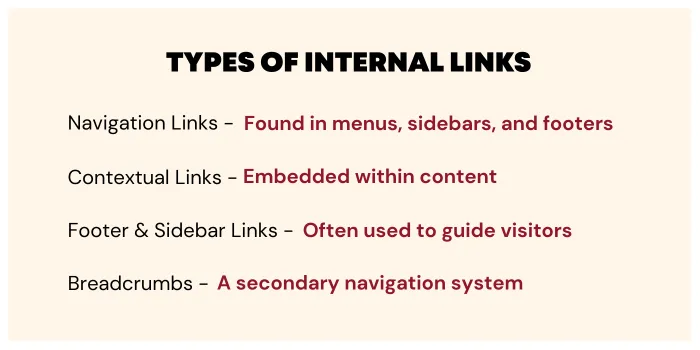
Internal links can be categorized into:
These are found in menus, sidebars, and footers to help users access key sections of a website.
Example:
A clothing website’s main menu might have links like:
Home | Men | Women | Sale | Contact Us
Embedded within content, these links provide relevant connections to related articles or pages.
Example:
A blog post about SEO best practices might say:
"Internal linking plays a crucial role in rankings. Learn how to structure internal links for better SEO [link to another blog]."
Often used to guide visitors to important sections like contact pages, service pages, or recent blog posts.
Example:
Footer links on a business website:
Privacy Policy | Terms & Conditions | About Us | Careers
A secondary navigation system that helps users track their journey within a site.
Example:
On an e-commerce site, a breadcrumb trail might look like this:
Home > Men’s Clothing > Jackets > Leather Jackets
Internal linking isn’t just about navigation; it directly impacts how search engines understand your website structure and distribute ranking power.
Google’s bots constantly scan websites to discover and rank new pages. They do this by following links. If a page on your site isn’t linked anywhere, Google might never find it. This is called an "orphan page," and it won’t appear in search results.
Example:
Let’s say you are writing a great blog post, but you don’t link to it from your homepage or other pages. Since there’s no clear path to it, Google may not index it, and visitors won’t find it either.
Not all pages on your website have equal ranking strength. Pages that are already ranking well (like your homepage) can pass some of their SEO strength to other pages through internal links.
Example:
If your homepage has strong authority and links to a new blog post, it passes some of its ranking power to that post. This helps the new or less visible page appear higher in search results over time.
Internal links encourage visitors to explore more content on your site, reducing bounce rates and increasing time spent on the page—both of which are positive signals for content SEO.
Example:
A reader lands on your article about SEO best practices. Within that post, they see a link to an in-depth guide on keyword research. If they click and keep reading, they stay on your site longer, which tells Google your content is valuable.
When you use internal links with keyword-rich anchor text, search engines better understand what your pages are about. This makes it easier to rank relevant topics.
Example:
Instead of linking with a vague phrase like "click here," use "SEO strategy guide" to link to a detailed SEO best practices article. This helps Google connect the topic with the linked page, improving its ranking potential.
A strong internal linking strategy isn’t just about adding links—it’s about creating a structured, user-friendly path that helps search engines understand your site while guiding visitors to the most relevant content. Here’s how to do it effectively:
A topic cluster is a structured way of organizing content around a main subject. At the center is a pillar page, which provides an in-depth overview of the topic. Supporting this are cluster pages, each covering subtopics in more detail. This setup helps search engines see relationships between pages, making it easier to rank for broad and specific keywords.
Example:
Imagine you run a digital marketing blog. Your pillar page could be:
🔹 “The Ultimate Guide to SEO” (covers SEO as a whole)
Your cluster pages would then dive into key subtopics:
🔹 "On-Page SEO Best Practices" (focusing on optimizing content and meta tags)
🔹 "Link Building Strategies" (covering internal and external linking)
🔹 "Technical SEO Checklist" (addressing site speed, indexing, and structured data)
Each cluster page links back to the pillar page and to related cluster pages, forming a web of interconnected content. This structure improves search engine rankings and keeps users engaged by offering relevant content paths.
Anchor text is the clickable text in a hyperlink, and it plays a role in how search engines understand the linked page. Instead of using vague terms like "click here", use keywords that describe the page's topic.
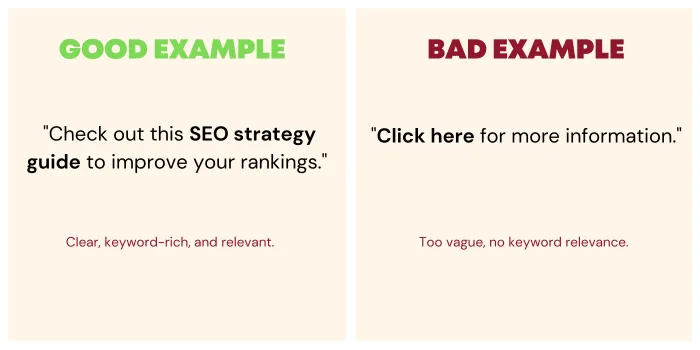
Best Practice:
Some pages on your website are more important than others. These might include service pages, cornerstone blog posts, landing pages, or high-converting product pages. The more internal links pointing to these pages, the stronger their content SEO signal.
Example for an E-commerce Site:
Example for a Service-Based Business:
Best Practice:
Internal links should feel like a natural part of the content, not forced in just for SEO. They should enhance the reader’s experience by providing additional helpful resources.
Good Example:
A blog post on "Common SEO Mistakes" could include:
"One mistake many website owners make is neglecting technical SEO [link to technical SEO checklist]. Ensuring proper site speed, indexing, and structured data can significantly improve your rankings."
Bad Example:
"Read our article about SEO mistakes. Click here [link] to learn more." (Generic, lacks context, and doesn’t add real value)
Best Practice:
To get the most out of your internal linking strategy, follow these best practices:
A well-structured internal linking system ensures that all pages get some visibility rather than concentrating all authority on just a few pages.
Best Practices:
Example:
A blog post on “SEO Best Practices” should link to detailed guides on:
Each linked page should also link back to relevant content to strengthen connections and enhance the user experience.
While internal links are useful, overloading a page with too many links can dilute their value and make navigation overwhelming.
Best Practices:
Example:
Instead of stuffing a blog post with 20+ internal links, focus on linking naturally to the most relevant and high-value pages.
Older blog posts can still drive traffic, but they need to stay updated and relevant. Adding internal links to fresh, high-value pages keeps content useful while improving content SEO.
Best Practices:
Example:
If you wrote a guide on SEO trends in 2022, you should update it with links to newer SEO strategies for 2025 to keep it fresh and authoritative.
As search algorithms evolve, internal linking strategies must adapt to new trends. Here’s what to focus on in 2025:
AI-powered SEO tools like Surfer SEO, Link Whisper, and Yoast SEO now recommend internal links automatically based on content analysis.
Why It Matters:
Example:
Instead of manually searching for internal linking opportunities, AI can analyze your content and recommend the most strategic places to add links.
Since over 60% of web traffic comes from mobile devices, your internal linking strategy should prioritize mobile usability.
Best Practices:
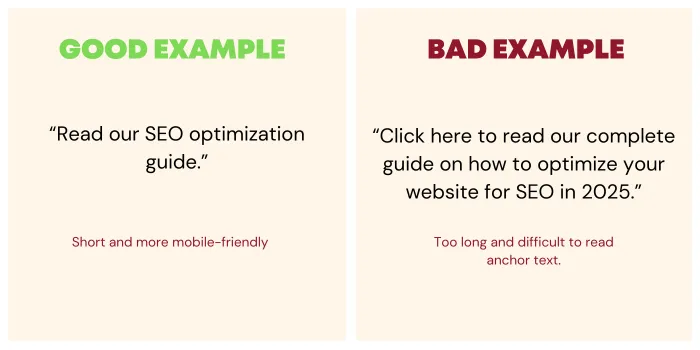
Search engines are now context-aware, meaning they rank pages based on how well they match user intent rather than just keyword matching.
Best Practices:
Example:
A reader on a "Beginner’s Guide to SEO" might be interested in:
They probably don’t need an advanced technical SEO audit guide at that stage, so linking to it wouldn’t be relevant.
Even with good intentions, some internal linking mistakes can hurt your SEO rather than help.
Fix: Stick to 3-5 links per 1,000 words for a balanced structure.
Fix:
Fix:
Fix:
A well-structured internal linking strategy isn’t just a minor SEO tweak. It helps search engines understand your content, boosts rankings, and keeps visitors engaged longer. Internal linking is one of the most effective (and often overlooked) ways to strengthen your SEO strategy.
If you want to optimize your internal links but don’t know where to start, LexiConn can help. We specialize in SEO-driven content strategies that improve site structure, increase visibility, and drive more traffic to your website.
We offer:
✅ SEO Content Writing – Well-structured, keyword-optimized content that naturally incorporates internal links.
✅ Content Audits & Optimization – Reviewing existing content to improve internal linking, readability, and SEO value.
✅ Website Content Strategy – Creating a structured, SEO-friendly content plan to ensure all pages are connected effectively.
✅ Landing Page & Blog Writing – High-quality, engaging content with strategic internal links for better search rankings.
✅ SEO Consulting – Expert guidance on optimizing your internal links and overall SEO strategy.
Want to see how this can work for your site? Try our free content pilot! Let’s build a stronger SEO foundation for your website with smarter internal linking.
Get in touch with LexiConn today and book a FREE 30-minute consultation!

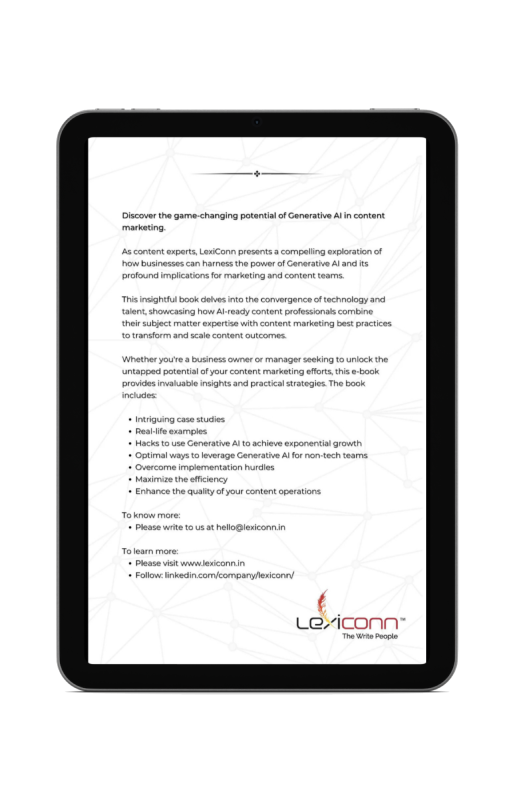
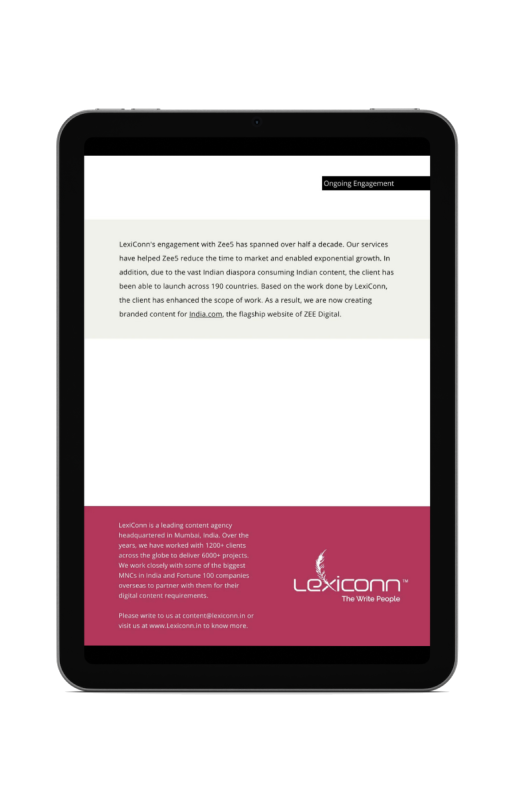
I have read and accept the Privacy Policy
Read More